Related Research Articles

Burns and Allen were an American comedy duo consisting of George Burns and his wife, Gracie Allen. They worked together as a successful comedy team that entertained vaudeville, film, radio, and television audiences for over forty years.
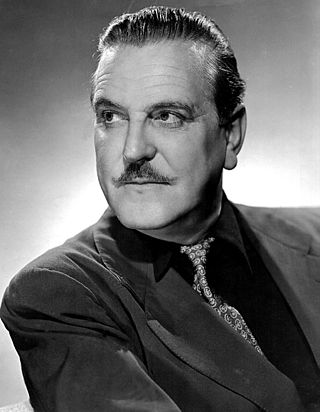
Francis Phillip Wuppermann, known professionally as Frank Morgan, was an American character actor. He was best known for his appearances in films starting in the silent era in 1916, and then numerous sound films throughout the 1930s and 1940s, with a career spanning 35 years mostly as a contract player at Metro-Goldwyn-Mayer. He is best-known for his multiple roles, including the title role of The Wizard in the 1939 MGM film The Wizard of Oz. He was also briefly billed early in his career as Frank Wupperman and Francis Morgan.

Dr. James Kildare is a fictional American medical doctor, originally created in the 1930s by the author Frederick Schiller Faust under the pen name Max Brand. Shortly after the character's first appearance in a magazine story, Paramount Pictures used the story and character as the basis for the 1937 film Internes Can't Take Money, starring Joel McCrea as Jimmie Kildare. Metro-Goldwyn-Mayer (MGM) subsequently acquired the rights and featured Kildare as the primary character in a series of American theatrical films in the late 1930s and early 1940s. Several of these films were co-written by Faust, who also continued to write magazine stories and novels about the character until the early 1940s. Kildare was portrayed by Lew Ayres in nine MGM films. Later films set in the same hospital featured Dr. Gillespie. Ayres returned to voice the Kildare character in an early 1950s radio series. The 1961–1966 Dr. Kildare television series made a star of Richard Chamberlain and gave birth to a comic book and comic strip based on the show. A short-lived reboot of the TV series, Young Doctor Kildare, debuted in 1972 and ran for 24 episodes.
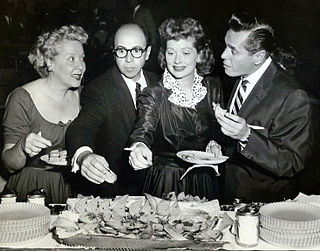
Jessurun James Oppenheimer was an American radio and television writer, producer, and director. He was the producer and head writer of the CBS sitcom I Love Lucy.

Fania Borach, known professionally as Fanny Brice or Fannie Brice, was an American comedian, illustrated song model, singer, and actress who made many stage, radio, and film appearances. She is known as the creator and star of the top-rated radio comedy series The Baby Snooks Show.

Maxwell House is an American brand of coffee manufactured by a like-named division of Kraft Heinz in North America and JDE Peet's in the rest of the world. Introduced in 1892 by wholesale grocer Joel Owsley Cheek, it was named in honor of the Maxwell House Hotel in Nashville, Tennessee, which was its first major customer. For nearly 100 years, until the late 1980s, it was the highest-selling coffee brand in the United States. The company's slogan is "Good to the last drop," which is often incorporated into its logo and is printed on its labels.

Alan Reed was an American actor, best known as the original voice of Fred Flintstone on The Flintstones and various spinoff series. He also appeared in many films, including Days of Glory, The Tarnished Angels, Breakfast at Tiffany's, Viva Zapata! and Nob Hill, as well as several television and radio series.

Funny Lady is a 1975 American biographical musical comedy-drama film and the sequel to the 1968 film Funny Girl. The film stars Barbra Streisand, James Caan, Omar Sharif, Roddy McDowall and Ben Vereen.

The Baby Snooks Show was an American radio program starring comedian and Ziegfeld Follies alumna Fanny Brice as a mischievous young girl who was 40 years younger than the actress who played her when she first went on the air. The series began on CBS September 17, 1944, airing on Sunday evenings at 6:30 pm as Post Toasties Time. The title soon changed to The Baby Snooks Show, and the series was sometimes called Baby Snooks and Daddy.

Hanley Stafford, was an actor principally on radio.

The Chase and Sanborn Hour is the umbrella title for a series of American comedy and variety radio shows sponsored by Standard Brands' Chase and Sanborn Coffee, usually airing Sundays on NBC from 8 p.m. to 9 p.m. during the years 1929 to 1948.

Everybody Sing is a 1938 American musical comedy film directed by Edwin L. Marin, and starring Allan Jones, Judy Garland and Fanny Brice, and featuring Reginald Owen and Billie Burke. The screenplay and story by Florence Ryerson and Edgar Allan Woolf had additional work by James Gruen and Milton Merlin with uncredited contributions from Bert Kalmar, Harry Ruby and Dalton Trumbo.
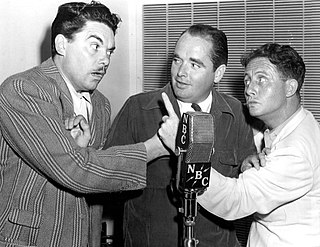
Tommy Riggs and Betty Lou is a radio situation comedy broadcast in various time slots from 1938 to 1946.
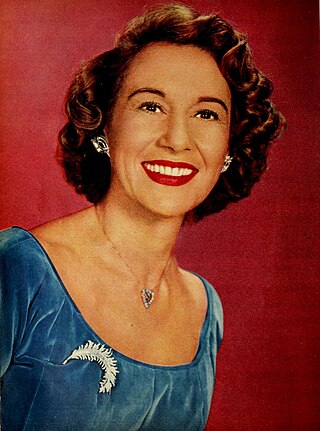
Blind Date is an old-time radio program in the United States. It was broadcast on NBC from July 8, 1943 until January 18, 1946.
Claudia and David is an American old-time radio drama. One version was broadcast on CBS July 4, 1941 – September 26, 1941 and another was syndicated in 1947.

The Frank Morgan Show is an American old-time radio variety program. It was broadcast on NBC from August 31, 1944, to May 31, 1945. It was described in a contemporary trade publication as "one of the highest priced programs on the air."
Hop Harrigan is an American old-time radio juvenile adventure program. It was broadcast on ABC from August 31, 1942, until August 2, 1946, and on Mutual from October 2, 1946, until February 6, 1948. General Foods began sponsoring the program on October 2, 1944; it had previously been unsponsored.
The Hour of Charm is an American old-time radio music program. It debuted on CBS on May 18, 1934, and had its final broadcast on CBS on May 2, 1948. The program also was broadcast on Armed Forces Radio, and after its network broadcasts ended, a new version was syndicated via transcriptions.
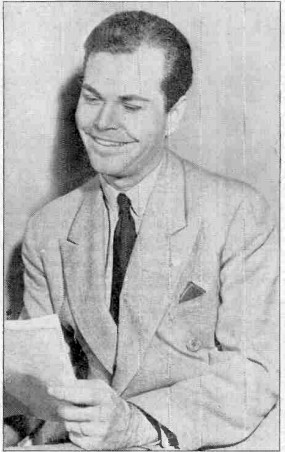
Howie Wing is an American old-time radio juvenile aviation adventure serial. It was syndicated by the World Broadcasting System and distributed initially to stations in Canada, beginning on January 31, 1938. The Don Lee Network began carrying it in the western United States on February 12, 1938. The program was broadcast weekdays on CBS from October 3, 1938, until June 30, 1939.

Kay Kyser's Kollege of Musical Knowledge is an American old-time radio musical quiz program starring Kay Kyser. It was broadcast on Mutual, NBC, and ABC beginning on February 1, 1938, and ending on July 29, 1949.
References
- 1 2 3 Dunning, John (1998). On the Air: The Encyclopedia of Old-Time Radio (Revised ed.). New York, NY: Oxford University Press. pp. 286–287. ISBN 978-0-19-507678-3 . Retrieved 2024-11-14.
- 1 2 3 Hilmes, Michele (1999). Hollywood and Broadcasting: From Radio to Cable. University of Illinois Press. pp. 73–74. ISBN 9780252068461 . Retrieved 9 February 2018.
- 1 2 Dunning, John (1976). Tune in Yesterday: The Ultimate Encyclopedia of Old-Time Radio, 1925-1976 . Englewood Cliffs, N.J.: Prentice-Hall. pp. 240-241. ISBN 0-13-932616-2.
- ↑ Reinehr, Robert C.; Swartz, Jon D. (2010). The A to Z of Old Time Radio. Scarecrow Press. p. 112. ISBN 9781461672074 . Retrieved 9 February 2018.
- ↑ Doran, Dorothy (November 4, 1937). "Star-Studded Broadcast Takes Over Show Boat Radio Hour Tonight". The Akron Beacon Journal. Ohio, Akron. p. 26. Retrieved February 9, 2018– via Newspapers.com.

- 1 2 Burroughs, Jack (March 27, 1938). "Celluloid to Ether". Oakland Tribune. California, Oakland. p. 71. Retrieved February 10, 2018– via Newspapers.com.

- ↑ Good News of 1938 - Episode 29 3/6 , retrieved 2023-05-19
- ↑ Grossman, Barbara W. (1992). Funny Woman. Indiana University Press. p. 222. ISBN 0253207622 . Retrieved 9 February 2018.
- ↑ Goldman, Herbert G. (1993). Fanny Brice: The Original Funny Girl . Oxford University Press. p. 179. ISBN 9780195085525 . Retrieved 9 February 2018.
Good News of 1938.
- ↑ Cullen, Frank; Hackman, Florence; McNeilly, Donald (2007). Vaudeville old & new: an encyclopedia of variety performances in America. Psychology Press. p. 144. ISBN 9780415938532 . Retrieved 9 February 2018.
- ↑ "Behind the Mike" (PDF). Broadcasting. July 1, 1938. p. 39. Retrieved 11 February 2018.
- 1 2 Guest, Edgar A. Jr. (February 20, 1938). "Hollywood Bungling Is an Argument for N.Y. Radio Shows". Detroit Free Press. Michigan, Detroit. p. 44. Retrieved February 11, 2018– via Newspapers.com.
